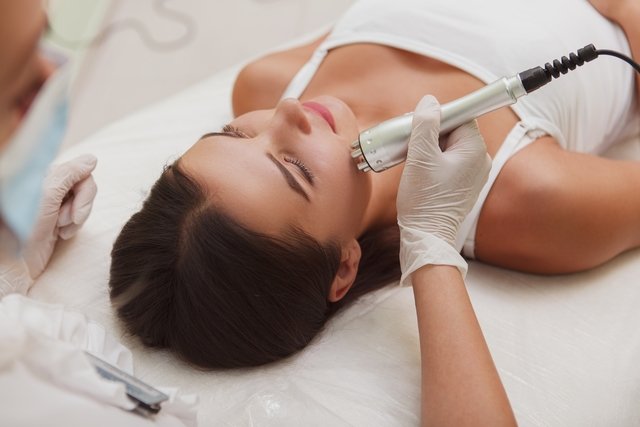Radiofrequency on the face is an aesthetic treatment that uses a heat source capable of stimulating the skin to produce new collagen fibers, improving the quality and elasticity of the skin, correcting expression lines and wrinkles, improving hydration and firmness of the face. .
Furthermore, this treatment increases blood circulation and keeps the skin firm, rejuvenated and oxygenated, being a safe, long-lasting and pain-free way to combat sagging of the face, and should be carried out by a dermatologist, beautician or a physiotherapist specialized in radiofrequency. .
Facial radiofrequency can be done around the eyes and mouth, forehead, cheekbones, chin and jowls, which are areas where the skin tends to become more flaccid and wrinkles and expression lines appear.

What is it for
Radiofrequency is indicated to combat the main signs of facial aging, such as:
- Sagging skin that gives a tired appearance or can change the facial contour;
- Wrinkles and expression lines around the eyes, forehead and nasolabial folds;
- Scar caused by acne;
- Jowls on the chin which give the sensation of a double chin.
In addition to radiofrequency on the face, this aesthetic treatment can also be carried out on other parts of the body to combat cellulite and localized fat present on the belly or culottes, for example. See other radiofrequency indications.
Who can do
Radiofrequency is indicated for all skin types in healthy adults, with intact skin, without wounds or infections, who want to eliminate everything from the first expression lines that appear around 30 years of age, to the deepest wrinkles that appear. They do not disappear when the skin is stretched, around the age of 40.
Furthermore, radiofrequency can be recommended for people who have acne scars, as it helps to reduce the appearance of these scars and improve the appearance of the skin. It is important that the area to be treated does not have any signs of inflammation, as in this case the treatment should not be carried out.
People who have double chins can also undergo this procedure, as it promotes the production of collagen there, which increases the firmness of the facial skin.
How to prepare
To perform radiofrequency on the face, certain precautions must be taken, such as:
- Avoid alcoholic drinksat least in the 2 days before the session;
- Prepare the skin with facial moisturizersfor 4 to 6 weeks before the session;
- Not wearing makeuplotions or moisturizing creams on the day of treatment;
- Do not shave or wax any area of the face on the day of the session;
- Inform the doctorbeautician or physiotherapist, if there is a history of cold sores.
Furthermore, peeling or laser treatment on the face should be avoided at least 2 weeks before the radiofrequency session.
How it is made
Radiofrequency on the face is performed by a dermatologist, beautician or physiotherapist specialized in this type of treatment and does not cause pain and does not require anesthesia.
Radiofrequency equipment emits electromagnetic waves that pass through the skin and reach the fat layer, located between the skin and the muscle, increasing local temperature, which increases blood circulation, tissue oxygenation and stimulates the formation of fibers. collagen, which gives firmness and support to the skin of the face.
The results of radiofrequency on the face can be observed approximately 2 or 3 days after the 1st treatment session and are progressive, because the electromagnetic waves cause existing collagen fibers to contract, giving the skin more firmness, in addition to stimulating formation of new collagen fibers, keeping the face rejuvenated and wrinkle-free.
How many sessions are recommended?
Normally, a minimum of 3 sessions is recommended, which must be done 15 to 30 days apart. From there, the therapist will be able to observe how the skin reacted and how many sessions should be needed to eliminate deeper wrinkles.
When the person reaches the goal, sessions can be held every 3 or 4 months as a form of maintenance.
To complement the treatment to combat sagging, it is also recommended to consume around 9 grams of collagen per day. Check out the list of foods rich in collagen.
Care after radiofrequency on the face
After the radiofrequency session on the face, it is recommended to use sunscreen and drink 1.5 to 2 liters of water per day to keep the skin hydrated.
In addition, daily skin care should be maintained, such as using anti-wrinkle cream and taking hydrolyzed collagen for best results.
Risks of radiofrequency on the face
The face is one of the body areas most at risk of burns because the bone ends are closer together and therefore the equipment must slide over the skin quickly and with circular movements. The therapist must constantly check the skin temperature, so that it does not exceed 41 degrees Celsius, as higher temperatures can leave burn marks.
If a small accident occurs and the skin area burns, the affected area must be treated with anti-burn ointments and radiofrequency can only be performed again when the skin is intact again.
Who shouldn’t do
Radiofrequency on the face should not be done by people with clotting problems, diabetes, Cushing’s syndrome or who have taken isotretinoin to treat acne in the last 2 months.
This treatment should also not be carried out in some cases such as:
- Presence of some change in sensitivity on the face, not differentiating between cold and heat;
- Use of metal prosthesis in the facial bones or metal filling in the teeth;
- Pregnancy;
- Use of anticoagulant medications or corticosteroids;
- Areas with tattoos on the face or permanent makeup;
- Use of a pacemaker;
- Wound or infection on the face;
- Fever;
- Autoimmune diseases or those that leave the immune system weakened.
In these cases, there may be a risk of increasing fever, worsening the infection, burning or not getting the expected result. Furthermore, radiofrequency should not be used under the thyroid as it can alter its functioning.

Sign up for our newsletter and stay up to date with exclusive news
that can transform your routine!
Warning: Undefined array key "title" in /home/storelat/public_html/wp-content/plugins/link-whisper-premium/templates/frontend/related-posts.php on line 12
Warning: Undefined array key "title_tag" in /home/storelat/public_html/wp-content/plugins/link-whisper-premium/templates/frontend/related-posts.php on line 13



